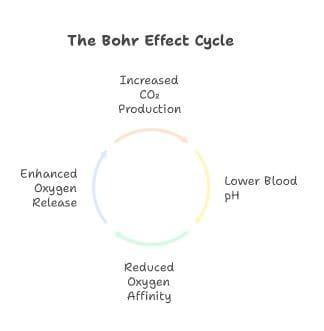When we think about breathing we usually only think about the oxygen your body needs to survive. Most people don’t know that the amount of CO₂ you have in your blood has a significant impact on how much oxygen your body can use. CO₂ tolerance impacts your stamina, your focus, how calm you are, and most importantly – your sleep.
Whether you are climbing stairs, running for a bus, doing a heavy workout, if you feel winded too quickly, it may not be your fitness level. It is more likely a lack of oxygen to your muscles and cells. Your body will struggle with low levels of carbon dioxide in your blood. If you understand this you can improve your fitness, not through heavy training, but from better breathing.
In this article learn why CO₂ has such an important role in oxygen delivery. You will also learn the signs of too little CO2, and the benefits to your health of increasing it.

CO₂’s Role in Oxygen Delivery
While oxygen gives your body fuel, carbon dioxide determines how much fuel gets used. The science behind this is called the Bohr effect. When you have a build up of carbon dioxide in your blood it signals your red blood cells to release oxygen to your tissues. Without enough carbon dioxide, some oxygen stays stuck in your blood instead of going to your your muscles, brain, and organs.
Here’s why oxygen delivery matters:
- CO₂ tolerance improves oxygen delivery. With a greater tolerance to CO₂ your body can handle more carbon dioxide, which allows oxygen to move into your tissues more efficiently.
- Better oxygen delivery leads to more endurance. With more oxygen entering your tissues and cells, you can keep going longer without gasping for air or feeling drained of energy.
- Breathing efficiency improves performance. Athletes train their CO₂ tolerance not just to breathe in harder conditions, but to use oxygen more efficiently.
- Daily life feels easier. Climbing stairs, exercising, or even your ability to handle stress becomes easier when more oxygen can reach your muscles and brain.
- Low CO₂ tolerance holds you back. If you breathe too fast or too much, carbon dioxide leaves your body too quickly, forcing your blood to hold onto oxygen instead of releasing it into your cells.
In basic terms, carbon dioxide is not just a waste gas but a mechanism that allows greater oxygenation of your body. Raise your CO2 tolerance, and you increase your energy, focus, and stamina for exercise and your everyday life.

Symptoms of Low CO₂ Tolerance
Breathing is a natural part of everyone’s lives whether done efficiently or not. Therefore, people don’t realize when their breathing is working against them. Because lower levels of CO2 tolerance are a regular part of the lives of many people that it is often blamed on aging or disease.
Common signs of low CO₂ tolerance include:
- Feeling short of breath while doing light activity.
- Frequent yawning, sighing, or needing to “catch your breath.”
- Shallow chest breathing instead of deep belly (diaphragmatic) breathing.
- Dizziness or lightheadedness when exercising.
- Trouble staying calm under stress or during sudden feelings of anxiety.
When you have low tolerance you are unable to balance oxygen and carbon dioxide. This causes you to breathe faster than needed which makes the issue worse. Most people think that taking in more air means more energy but doing so by taking many quick breaths is the worst thing you can do if you need more energy. You may take in more oxygen to your body but much of it is unused and won’t get delivered to your muscles and brain.
As time passes your poor inefficient breathing habits end up sapping you of energy and increasing your stress levels making goals such as losing weight and building muscle much harder. Unfortunately the situation gets worse as your poor breathing also leads to poor sleep, which makes everything else worse.
Being aware of these problems allow you to take steps to improve your breathing and, in turn, your health. Better breathing increases your CO₂ tolerance and builds a base for more energy, focus, and sleep.

Benefits of High CO₂ Tolerance
By increasing your tolerance of CO₂ you provide your body with the oxygen it needs to function properly. The benefits of doing so go beyond better breathing, helping you improve your health and your life.
Physical Benefits
- More energy and endurance – You are able to sustain longer workouts without becoming tired with better oxygen delivery.
- Better recovery – With oxygen being released to your tissues you are able to more quickly and more fully recover from workouts and daily stress.
- Lower heart rate and blood pressure – Better breathing results in calmer breathing. This rhythm reduces stress on your cardiovascular system.
- Better circulation – Blood vessels dilate more with higher CO₂, improving nutrient and oxygen flow throughout the body.
Mental and Emotional Benefits
- Better focus – Increased and steady oxygen supply to the brain keeps the mind clear and alert.
- Reduced anxiety and stress – Better breathing and higher CO₂ tolerance activates your parasympathetic nervous system, which brings calm. Increased oxygenation of the brain also brings a more calm state.
- Improved stress resilience – You stay more composed under pressure, whether in sports, work, or daily situations.
Sleep and Longevity Benefits
- Deeper sleep – Better breathing decreases the chance of snoring and sleep apnea, which helps for better sleep quality, giving you more time for deep sleep..
- Cellular health – Better breathing efficiency provides energy at the cellular level, which might slow signs of aging [x].
- Long-term well being – Better oxygen and carbon dioxide balance improves both brain and heart operation and health.
Increasing your tolerance to CO₂ creates a strong base for better health, more energy, and better physical and mental performance throughout the day.

How to Improve CO₂ Tolerance Safely
Increasing CO₂ tolerance doesn’t require you to do difficult or extreme workouts. Nor does it require anything other than yourself and active breathing exercises. Small, consistent changes in the way you breathe can lead to big results. The key is to train your body to stay calm with increasing levels of carbon dioxide, while breathing less.
Everyday Breathing Habits
- Switch to nasal breathing – Breathe through your nose during rest, exercise, and even sleep. By doing so you slow airflow, boost oxygen efficiency, and naturally increase CO₂ tolerance.
- Slow down your breath – Try for about 6 breaths per minute – about 5 to 6 second inhales and exhale – in a relaxed state throughout the day. Slow breathing improves circulation and helps your body accept more carbon dioxide.
- Breathe light, not hard – Faint, gentle, controlled breathing decreases over-breathing and helps keep more CO₂ in your system. Your breath should be so quiet you can’t hear it.
Simple Breathing Exercises
- Breath-hold practice – After a normal exhale, hold your breath until you feel the first urge to breathe. Take a few more normal breaths and repeat a breath hold a few times to train improved tolerance.
- Walking breath holds – Take a short walk while holding your breath briefly after an exhale. Try holding for 3 or 4 paces and work up to over 20 paces. Try to recover calmly by taking 2 or 3 normal breaths and repeating your breath hold. This builds endurance without stress
- Posture and relaxation – Stand up straight while relaxing your shoulders. A relaxed chest and diaphragm allow deeper more relaxed breath.
Safety Tips
- Start small – Increase your practice slowly so your body can adapt without strain.
- Never force long breath-holds – Having discomfort is normal, but being in pain or being dizzy is a sign to stop.
- Listen to your body – Everyone improves at different rates. By being patient and consistent you achieve lasting results.
You can safely increase your tolerance to CO₂ by not pushing yourself too hard. Also, staying consistent can ensure you reach your goals and unlock more energy for your daily life and greater performance demands.
Conclusion: Improving CO₂ Tolerance
Better breathing not only determines the amount of air you take in but also how much oxygen your body uses. Improving CO₂ tolerance allows for more oxygen delivery to your cells, greater stamina, sharper focus, and more calmness. These benefits support better workouts, better thinking, and more restful sleep.
If you want a performance boost, you don’t need extreme training for results, simply adjust your breathing to slower, lighter, and more steady nasal breathing. This is the basis for greater endurance and better health.
Start practicing nasal breathing today, and you’ll notice the difference soon after. Practice safe breath holds and you’ll boost your performance and your ability to stay calm for you morning jog or that stressful meeting. Start slow but stay consistent to improve your health and regain your edge.
Check out What Functional Breathing Actually Means.







